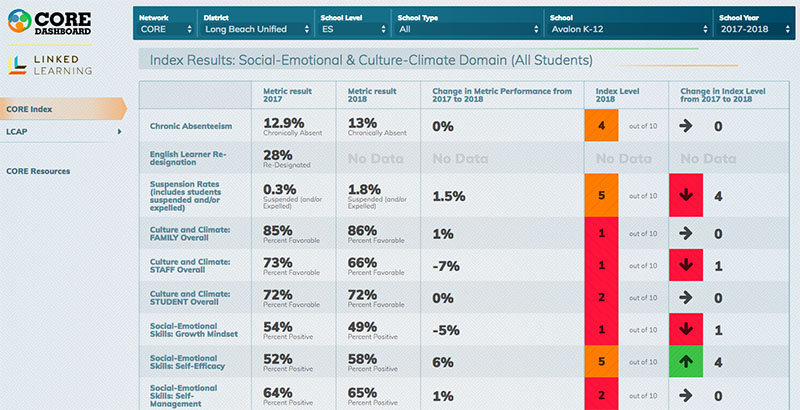How 8 Large California Districts Are Using Data to Decode Social-Emotional Learning — and Predict Students’ Academic Success

When some teachers in the Long Beach Unified School District hear students say they’re bad at math, they rephrase. You’re not bad, you’re just not understanding it yet. It’s not too difficult, it’s just challenging right now.
These educators are helping students develop a growth mindset, a belief that they can improve their skills through effort. A growth mindset is one of four social-emotional learning traits the district — along with others in California — are trying to teach their students.
These schools use surveys and data analysis to track not just how well they are teaching social-emotional traits, but also how they are affecting college and career readiness indicators, such as academic achievement or graduation. So far, they’ve seen some promising findings.
“We’ve had schools that have really focused heavily on growth mindset and have seen some significant gains in … achievement in English language arts and math without significant changes in pedagogy, meaning that by just shifting the mindset of students, you can actually get them to improve in their math skills and their reading skills,” said Christopher Lund, assistant superintendent of research and school improvement in the Long Beach district.
Long Beach is part of the CORE Districts, a group of eight of the largest California districts that have created a partnership to help track how students are growing in both their academic and social-emotional skills. Education Analytics, a Wisconsin-based nonprofit, is helping decipher the data for them and refine their social-emotional measurement tools.
The challenge of measuring this is the topic of a panel at South By Southwest Education on March 6 titled “Integrating SEL into Data Systems for Improvement.” Noah Bookman, chief strategy officer of the CORE Districts, will join Libby Pier and Andrew Rice of Education Analytics for a one-hour conversation.
“We have, we think, the largest instance of a common measure of social-emotional skills that’s ever happened in the field of education. About a half-million students per year participate in this instrument,” Bookman said. “One thing I hope [the SXSW audience] sees is that you can measure social-emotional learning in a meaningful and useful way.”
The discussion will cover the history of the CORE Districts’ interest in social-emotional learning, the development of their survey, and how the data analysis has helped them see how different subgroups of students are learning these skills.
CORE first partnered with Education Analytics in 2014. Together, they created a student growth model to track how well kids were doing over time in subjects like reading and math, as well as other factors like graduation, chronic absenteeism, and suspension rates.
Education Analytics also helped refine and improve a survey that CORE was using to track social-emotional learning. Specifically, CORE measures growth mindset, self-efficacy (believing in one’s ability to succeed), self-management, and social awareness (ability to empathize), in addition to school culture and climate indicators such as support for academic learning, a sense of belonging, knowledge and fairness of rules and discipline, and school safety. These metrics are then displayed on a data dashboard searchable at the school level.
Through a data collaborative, schools both inside and outside the CORE districts in California are using these social-emotional learning surveys — reaching nearly 500,000 students.
Schools are able to see not just how well their students are performing, but also how well students at other schools are doing, to provide benchmarks and context for their data.
This large collection of student social-emotional data has sparked some interesting research analysis — for example, a recent report found that students who took these surveys improved in their growth mindset from 2014 to 2016 but decreased in social awareness, self-efficacy, and self-management. Specifically, girls’ self-efficacy took a huge dive in middle school compared with their male peers.
In the Long Beach district, there is no mandate that schools implement a specific program or policy to address their social-emotional learning indicators. Instead, Lund said, schools can lead this effort. When educators saw problems they wanted to address in their data, some adopted an additional social-emotional learning curriculum. Others created training nights for parents and teachers to share ways to speak to children that encouraged skills like growth mindset. One high school developed a special two-period math course for struggling students that teaches algebra for one half of the class and social-emotional skills during the other.
Figuring out how to measure whether students are learning social-emotional competencies is still a challenge, and researchers caution against relying on these measures for stringent accountability purposes. Surveys are a common measurement tool, but other options include assessments, interviews, and observation of students.
“We’re still early in the measurement science behind a lot of this, and there’s a lot to learn, but there’s a lot to do in the meantime,” Rice said.
Pier hopes panel attendees will come away with an open mind for different ways to measure social-emotional learning.
“A student self-report survey can provide some useful information and can provide actionable information for schools as they’re thinking about how to continue to improve,” Pier said.
Disclosure: The Bill & Melinda Gates Foundation provides financial support to the CORE Districts and The 74.
Get stories like these delivered straight to your inbox. Sign up for The 74 Newsletter

;)
